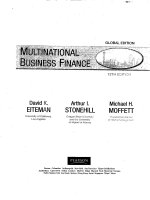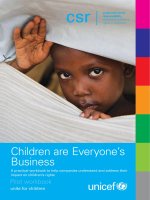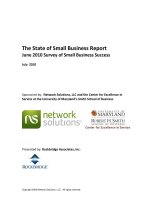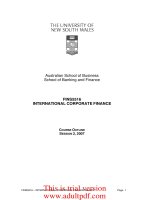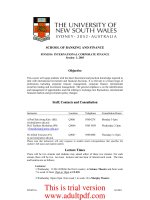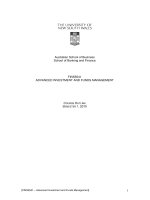Essential of Multinational Business Finance Practical Approach potx
Bạn đang xem bản rút gọn của tài liệu. Xem và tải ngay bản đầy đủ của tài liệu tại đây (6.88 MB, 157 trang )
Essential of Multinational
Essential of Multinational
Business Finance
Business Finance
Practical Approach
Practical Approach
Professor M. Vaziri
Professor M. Vaziri
Content
Content
Content
Content
Chapter 1
Chapter 2
Chapter 3
Chapter 4
Chapter 5
Chapter 6
Chapter 23
Chapter 14
Chapter 14
Chapter 18
Chapter 18
Chapter 15
Chapter 15
Chapter 20
Chapter 20
Chapter 11
Chapter 11
Chapter 22
Chapter 22
International Banking
International Banking
International Financial Market
International Financial Market
Content
Content
Chapter 1
Chapter 1
Financial Goals and Corporate
Financial Goals and Corporate
Governance
Governance
■
Multinational business enterprise and finance
■
A business having operating subsidiaries,
branches, or affiliates located in foreign
countries.
■
Can be engaged in virtually every type of
business activity, including banking, accounting,
consulting, etc.
■
Business activities, primarily financing, which
reach beyond the domestic markets.
■
Major risks include interest rate, exchange rate, and
credit risks of foreign markets.
Content
Content
Chapter 1
Chapter 1
Financial Goals and Corporate
Financial Goals and Corporate
Governance
Governance
■
Goal of management : Shareholder Wealth
Maximization versus Corporate Wealth Maximization
■
Shareholder Wealth Maximization (SWM Model)
■
Is the predominant theory of domestic U.S. firms
■
Assumes that the stock market is efficient and all news
(public or private) is reflected in the stock price.
■
Risk = added risk that the firm’s share bring to an
established investment portfolio.
■
Systematic Risk = the non-diversifiable risk inherent in
the market, therefore it cannot be eliminated.
■
Unsystematic Risk = the diversifiable risk of an
individual.
Content
Content
Chapter 1
Chapter 1
Financial Goals and Corporate
Financial Goals and Corporate
Governance
Governance
■
Weaknesses of Shareholder Wealth
Maximization (SWM)
■
Short-term gains vs. long-term gains – Some
managers attempt to maximize short-term
shareholder wealth at the expense of the long-
term profitability of the company.
■
Agency Theory Managers and owners may
not share the same goals and objectives.
Problem arises as shareholders seek effective
motivational tools to promote managers
conformity to will of shareholders.
Content
Content
Chapter 1
Chapter 1
Financial Goals and Corporate
Financial Goals and Corporate
Governance
Governance
■
Corporate Wealth Maximization
■
The firm treats shareholders as equals to other
groups with interest in the firm (management,
labor, local community, supplies, creditors, etc).
■
Risk = total risk = Operational + Financial Risk.
■
Concerned with growing the firm for the benefit of
all, not exclusively shareholders.
■
Is the predominant theory of many foreign firms.
■
A few foreign firms are adopting the SWM model.
Content
Content
Chapter 1
Chapter 1
Financial Goals and Corporate
Financial Goals and Corporate
Governance
Governance
■
Weaknesses of Corporate Wealth Maximization (CWM)
■
Attempts to satisfy too many parties simultaneously. It may be to
provide adequate satisfaction to any single party.
■
Corporate Governance
■
Relationship among firm’s stakeholders to control the objectives and
strategic direction of the firm.
■
U.S. and similar markets use the “one share = one vote” voting
system. While many foreign firms issues separate classes of voting,
limited voting, and non-voting shares.
■
Due to abuses and failures of internal corporate self-governance,
government and outside agencies must enact legislation regulating
activities. One such law is the Sarbanes-Oxley Act of 2002.
Content
Content
Chapter 1
Chapter 1
Financial Goals and Corporate
Financial Goals and Corporate
Governance
Governance
■
Three major characteristics of
Sarbanes-Oxley
■
CEO’s of publicly traded firms must
personally certify company’s public financial
statements.
■
Corporate boards must have independent
auditors.
■
Companies cannot make loans to company
directors.
Content
Content
Chapter 1
Chapter 1
Financial Goals and Corporate
Financial Goals and Corporate
Governance
Governance
■
Basics of Corporate Governance
■
The way a corporation directs itself is called corporate
governance. Primarily, corporate governance states the
techniques that govern the formation of a corporation’s
structure and the laws and customs that affect these
techniques.
■
A corporation’s structure is composed of three groups:
■
Board of Directors
■
Managers
■
Shareholders
Content
Content
Chapter 2
Chapter 2
International Monetary System
International Monetary System
(IMS)
(IMS)
■
Structure of IMS: Framework within which the foreign
Exchange rates are determined, capital flows &
international trade are accommodated & Balance of
Payments Adjustments are made
■
History of IMS: The Gold Standard (1876-1913):
Gold as a medium of exchange- Pharaohs (3000 PC)
The Greeks, Romans & Persians Used gold coins &
passed through the mercantile era to the 19th
century
No multinational agreement, but each country
declared a par value for its currency in terms of gold
based on rule of games or "Gold Standard"
Content
Content
Chapter 2
Chapter 2
International Monetary System
International Monetary System
(IMS)
(IMS)
■
Mercantilism of 19th Century - Need for IMS :
Europe adapted the IMS in 1870 & the U.S in 1879
$20.67/Ounce of Gold, £4.274/Ounce:
$20.67/£4.2474=£4.8665/$
Limitation of gold reserve & supply of money
Limit the flow of goods and gold & suspension of GS
■
Inter War Years: 1914-1944:
Free Fluctuating of Exchange Rates with consideration of
the gold and par value of other currencies.
Short sell of week currencies, re-evaluation of £, the
collapse of the Austrian banking system-total abandonment
of GS
Content
Content
Chapter 2
Chapter 2
International Monetary System
International Monetary System
(IMS)
(IMS)
■
The Bretton Wood Agreement: (1944):
Dollar based Monetary System (par value based on $)
Fixed value in term of $, but not required to convert
Only $ remained convertible to gold: $35/Ounce
Only 1% of par allowed for fluctuation
Devaluation was not allowed for purpose of high export
10% devaluation for week currency or approval of IMF
IMF & World Bank were created
Former Soviet Union did participate at Bretton Wood but
chose not to join IMF or World Bank
Content
Content
Chapter 2
Chapter 2
International Monetary System
International Monetary System
(IMS)
(IMS)
■
International Monetary Fund IMF
■
Mission: Rendering temporary assistance to currencies with cyclical,
Mission: Rendering temporary assistance to currencies with cyclical,
seasonal or random fluctuation.
seasonal or random fluctuation.
■
Help countries with a structural trade problem
Help countries with a structural trade problem
■
IMF is funded based on quota of expected post WWII trade
IMF is funded based on quota of expected post WWII trade
■
The Original quota were 25% in gold or $ (Gold tranche), & 75% local
The Original quota were 25% in gold or $ (Gold tranche), & 75% local
currency.
currency.
■
A member country can borrow up to its original 25% in gold or convertible
A member country can borrow up to its original 25% in gold or convertible
currencies in any 12 month plus 100% of its total quota. A member
currencies in any 12 month plus 100% of its total quota. A member
country can also borrow up to 120% of its quota in convertible currency or
country can also borrow up to 120% of its quota in convertible currency or
gold, even through it only paid 25% in convertible currency or gold.
gold, even through it only paid 25% in convertible currency or gold.
■
At the present time, each of the 151 member can borrow up to 150%
annually of its quota or up to 450% during a three years period
■
Cumulative access could be up to 600% of members quota
Content
Content
Chapter 2
Chapter 2
International Monetary System
International Monetary System
(IMS)
(IMS)
■
International Monetary Fund IMF (Cont’)
■
Distribution of the quota is prelude to distribution of vote
Distribution of the quota is prelude to distribution of vote
■
U.S. Vote:19.1%, UK:6.6%, Germany:5.8%, France:4.8%,
U.S. Vote:19.1%, UK:6.6%, Germany:5.8%, France:4.8%,
Japan:4.5%, Canada:3.2%
Japan:4.5%, Canada:3.2%
■
General Agreement to Borrow: IMF ability to borrow from member
General Agreement to Borrow: IMF ability to borrow from member
countries, currently more than $180 billion.
countries, currently more than $180 billion.
■
Special Drawing Rights (SDR): created according to Rio de Janeiro
Special Drawing Rights (SDR): created according to Rio de Janeiro
agreement (1967) to help increase the global trade between nations
agreement (1967) to help increase the global trade between nations
■
SDR is distributed based on members quota and valued based on 16
SDR is distributed based on members quota and valued based on 16
then 5 currency
then 5 currency
■
First $/SDR determined then value of other currencies are measured
First $/SDR determined then value of other currencies are measured
Content
Content
Chapter 2
Chapter 2
International Monetary System
International Monetary System
(IMS)
(IMS)
■
Monetary Development: (1944-1971)
■
EFTA (1957) & EEC (1959), rapid increase in world trade
EFTA (1957) & EEC (1959), rapid increase in world trade
■
U.S deficit of 1959 & International Monetary Reserve dilemma: BOP
U.S deficit of 1959 & International Monetary Reserve dilemma: BOP
deficit to create more reserve for LDCs
deficit to create more reserve for LDCs
■
Doubt of convertibility of major reserve currencies
Doubt of convertibility of major reserve currencies
■
"Interest Equalization Tax“ on foreign borrowing & creation of Euro-
"Interest Equalization Tax“ on foreign borrowing & creation of Euro-
bond
bond
■
Mandatory control of direct foreign investment ,control of foreign
Mandatory control of direct foreign investment ,control of foreign
lending by U.S banks,& high U.S deficit
lending by U.S banks,& high U.S deficit
■
Official Currency Swaps: Group of Ten Industrialized Nations as a
Official Currency Swaps: Group of Ten Industrialized Nations as a
interest credit between central banks
interest credit between central banks
Content
Content
Chapter 2
Chapter 2
International Monetary System
International Monetary System
(IMS)
(IMS)
■
Monetary Development: (1944-1971)
■
U.S. BOT had reached to all-time high in 1971
U.S. BOT had reached to all-time high in 1971
■
U.S lost one-third of her official gold & president Nixon suspended
U.S lost one-third of her official gold & president Nixon suspended
convertibility of $ to gold
convertibility of $ to gold
■
U.S. imposed 10%surcharge on imports & freezes P&W
U.S. imposed 10%surcharge on imports & freezes P&W
■
Most European currencies gained against $
Most European currencies gained against $
■
Smithsonian agreement: December of 1971:
■
Group ten Industrialized Nations signed on Dec, 17 1971
Group ten Industrialized Nations signed on Dec, 17 1971
■
$ devaluated to $38/Ounce, Yen evaluated against $ :16.9%, Canada
$ devaluated to $38/Ounce, Yen evaluated against $ :16.9%, Canada
7.4%
7.4%
■
Floatation of 2.25% (Max 4.5%) is allowed
Floatation of 2.25% (Max 4.5%) is allowed
■
$ lost its value sharply: $42.22 in free market, $70 in official London
$ lost its value sharply: $42.22 in free market, $70 in official London
market
market
Content
Content
Chapter 2
Chapter 2
International Monetary System
International Monetary System
(IMS)
(IMS)
■
Jamaican Agreement: January 1976:
■
Floating Rate has been established ( has continued today)
Floating Rate has been established ( has continued today)
■
Gold was demonetarized as a reserved asset
Gold was demonetarized as a reserved asset
■
IMF agreed to sell $25 million ounces of gold to its members and used
IMF agreed to sell $25 million ounces of gold to its members and used
the proceeds to help the poor nations
the proceeds to help the poor nations
■
IMF quota increased to $41 and then to $180 billion
IMF quota increased to $41 and then to $180 billion
■
10% of the voting power given to OPEC members
10% of the voting power given to OPEC members
■
Non-oil producing countries have more access to IMF
Non-oil producing countries have more access to IMF
■
Floating Exchange Rate System has officially adopted & continued
Floating Exchange Rate System has officially adopted & continued
until present time
until present time
Content
Content
Chapter 2
Chapter 2
International Monetary System
International Monetary System
(IMS)
(IMS)
■
Plaza Agreement
■
Louvre Agreement
■
/>choi/cur.htm
Content
Content
Chapter 3
Chapter 3
Balance of Payment (BOP)
Balance of Payment (BOP)
■
Definition of BOP: Record of transactions between
residents of one country & rest of the world
■
Functions of BOP:
■
Helps forecast market potential of a country
■
Helps to understand the currency fluctuation of a country
■
It is a poor description of National Economy
■
Useful in measuring economic performance if there is FER
■
$ was indexed at 100 at 1970: If index is greater
than 100,$ gain VS other countries currencies.
Content
Content
Chapter 3
Chapter 3
Balance of Payment (BOP)
Balance of Payment (BOP)
■
Accounts of BOP:
■
Trade Balance : Net balance in merchandise traded
■
Current Account: Trade account + earning & expense on services
■
Performed service: travel, shipping, banking, insurance, etc
■
Debt service: interest, dividend received or paid abroad.
■
Basic Balance: Current account +long term capital (such as direct
investment)
■
Overall Balance: basic Balance + short term capital +Error &
Omission
■
Unilateral Transfer: no corresponding flow of G&S-non military
goods, grants, foreign aids, donation, inheritance
■
Capital account: record of investment & payments
Content
Content
Chapter 3
Chapter 3
Balance of Payment (BOP)
Balance of Payment (BOP)
■
Macro Modeling of BOP:
■
Aggregates Income: Y=C+S, Where,
■
C = Agg. Consumption & S = Agg. Saving
■
Aggregate Expenditure: E= C+Id, where Id=Domestic investment
■
Y-E=S-Id
■
If Y is greater than E, S is greater than Id
■
Sector of Economy
■
Consumer Sector (C)
■
Business Sector (Investment): - Id and If
■
Government Sector (G)
■
Foreign Sector = Export (X) – Import (M)
Content
Content
Chapter 3
Chapter 3
Balance of Payment (BOP)
Balance of Payment (BOP)
■
Balance Economy
■
Y-E=0
■
S (Saving) – Id = 0 : Saving Balance
■
G – T (Tax) = 0: Budget Balance
■
Export (X) – Import (M) = 0: Trade Balance.
■
In a balance Economy: Y=E, then S= Id, then G=T, then X=M
* If Y>E, then S> Id (Saving Surplus), then T>G (Budget
Surplus), then X>M (Trade Surplus). So If > 0 (Capital
Outflow)
* If Y<E, then S< Id (Saving Deficit), then T<G (Budget
Deficit), then X<M (Trade Deficit). So If < 0 ( Capital Inflow)
Content
Content
Chapter 3
Chapter 3
Balance of Payment (BOP)
Balance of Payment (BOP)
■
Coping with Current Account Deficit (CAD):
■
Relationship between CAD & currency depreciation
■
According to General Equilibrium View : not a simple
one
■
1976-1980: $ depreciate, CAD decreased
■
1980-1985: $ appreciate, CAD increased
■
Impose high tariffs & quotas:
■
Since S-Id=X-M, (unless S & Id changes), if M decline, X must
decline : less import means less demand for foreign currency,
less supply of domestic currency, and an increase in value of
domestic goods, which mean less export.
Content
Content
Chapter 3
Chapter 3
Balance of Payment (BOP)
Balance of Payment (BOP)
■
End Foreign ownership of domestic assets
■
No capital account surplus means interest
rate will increase & investment & income
will decline
■
Stimulate savings: If S is greater than Id,
we will have capital outflow, causing
deficit to decrease in both Government
budget & Current Account.
Content
Content
Foreign Exchange
Foreign Exchange
Market
Market
Euro €
£
Can$
SFranc
¥
